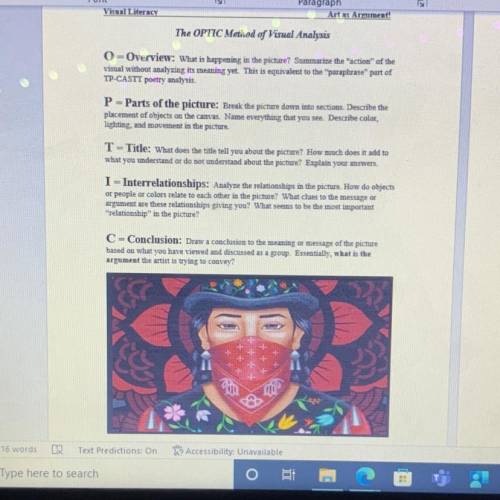13131
The OPTIC Method of Visual Analysis
0 - Overview: What is happening in the picture? Su...

English, 01.02.2022 16:20 justiceisbae1
13131
The OPTIC Method of Visual Analysis
0 - Overview: What is happening in the picture? Summarize the "action" of the
visual without analyzing its meaning yet. This is equivalent to the "paraphrase" part of
TP-CASTT poetry analysis.
P = Parts of the picture: Break the picture down into sections. Describe the
placement of objects on the canvas. Name everything that you see Describe color,
lighting, and movement in the picture.
T = Title: What does the title tell you about the picture? How much does it add to
what you understand or do not understand about the picture? Explain your answers.
I = Interrelationships: Analyze the relationships in the picture. How do objects
or people or colors relate to each other in the picture? What clues to the message or
argument are these relationships giving you? What seems to be the most important
relationship" in the picture?
C = Conclusion: Draw a conclusion to the meaning or message of the picture
based on what you have viewed and discussed as a group. Essentially, what is the
argument the artist is trying to convey?
27
3
Tds
DE
Text Predictions: On
Accessibility: Unavailable


Answers: 2


Another question on English

English, 21.06.2019 18:40
How does the author's purpose affect his or her text structure
Answers: 1

English, 21.06.2019 21:00
Take some time to create a cultural inventory. note the components of culture that have defined you and list as many as possible here. then write about the ways your unique culture affects your communication, i need i don't know how to start it off .
Answers: 1

English, 22.06.2019 01:00
Read the passage from animal farm. "that was part of the arrangement! " cried squealer. "jones's shot only grazed him. i could show you this in his own writing, if you were able to read it. the plot was for snowball, at the critical moment, to give the signal for flight and leave the field to the enemy. and he very nearly succeeded—i will even say, comrades, he would have succeeded if it had not been for our heroic leader, comrade napoleon. do you not remember how, just at the moment when jones and his men had got inside the yard, snowball suddenly turned and fled, and many animals followed him? and do you not remember, too, that it was just at that moment, when panic was spreading and all seemed lost, that comrade napoleon sprang forward with a cry of 'death to humanity! ' and sank his teeth in jones's leg? surely you remember that, comrades? " exclaimed squealer, frisking from side to side. now when squealer described the scene so graphically, it seemed to the animals that they did remember it. at any rate, they remembered that at the critical moment of the battle snowball had turned to flee. but boxer was still a little uneasy. how does the characterization of squealer support the author’s purpose? squealer's dramatic accusations draw parallels between him and stalin’s propagandists. squealer's uncertainty shows that he is not a reliable ally of napoleon and is ineffective with messaging. squealer's ability to get the animals to listen to him shows that any animal can rise to be a leader in time. squealer's humble interactions with the animals reflect the importance of equality and cooperation.
Answers: 3

English, 22.06.2019 07:30
50 points what are three examples of logos, pathos, and ethos in the declaration of independence.
Answers: 2
You know the right answer?
Questions





Mathematics, 29.10.2020 17:10



Chemistry, 29.10.2020 17:10


History, 29.10.2020 17:10


Mathematics, 29.10.2020 17:10


Computers and Technology, 29.10.2020 17:10








